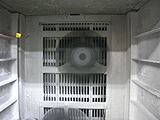Studies of the cooling device and the environment load
 Frost formation of cooler
Frost formation of cooler
|
Research and development of high-quality freezers
Nowadays, there are many freezers having several new functions.
However, we do not have any fair evaluation methods of such freezers.
In this study, we establish the best method, and verify the difference between the new and classic ones.
|
 Unit cooler performance test device
Unit cooler performance test device
|
Development of proficiency test of freezing ability in unit cooler
Refrigerated warehouses are used as places of freezing foods or cryopreservation.
The test of freezing ability in unit cooler is examined based on JIS-B-8610 or JIS- B-8626.
However, these tests have some problems such as making accidental errors or needs of long time to test.
We think that these tests are not fair.
In this study, we make new test which has high qualities.
|
 The Ministry of Agriculture Forestry and Fisheries, 2009 food loss statistical research
The Ministry of Agriculture Forestry and Fisheries, 2009 food loss statistical research
|
Effects of reduction of food loss on environmental loads
We cannot survive without foods.
Therefore, the environment loads caused by making any foods is originated from human lives.
Since it may be suggested that the value of foods, however, arises when human eat them, food looses which are not eaten at all seem not to be essential.
Indeed, it is reported that the food loss account for 5 to 10 % of all amount of foods, so we should make an effort to reduce it in its distribution.
However, the environment loads are calculated in each product in Carbon Footprint of Products (CFP), the food losses are not considered in this valuation.
As the result, it may not be motivated to reduce the food losses.
We have to estimate the environment loads in the amount of consumption that gets rid of food looses from all amount of production, and enable to evaluate the effect reducing the food losses.
In this study, as we calculate environment loads of life cycles in refrigerated and frozen distributions on the amounts of consumption and compare them, we want to quantitatively show that the frozen distribution has better possibility reducing the environment load than refrigerated one.
|
 The CO2 discharge quantity per 1t in the freezing transport and refrigeration transporting
The CO2 discharge quantity per 1t in the freezing transport and refrigeration transporting
of the tuna
|
Environment loads and qualities on transportation of aquatic products
Since most customers of Japanese people need high quality aquatic products, the high cost transportations are required for example delivering living fishes by airplanes.
However, it is not scientifically revealed whether the cost corresponds to the quality or not.
In this study, we quantify the environment loads in transportation of aquatic products by The Life Cycle CO2(LC-CO2) and inspect the foods' qualities in each situation, and we suggest the best transportation method that warrants a certain qualities of foods and minimizes the costs.
|
|

